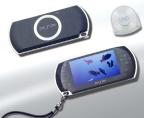We’ve published another piece by Steve, where he covers How-To get your Sony PSP to access the Internet.
 Sony have produced a portable games console which on its own merit is going to sell a lot of units. However it has the possibility of becoming a portable media hub that will give even Microsoft a jolt by driving into their Portable Media Center market.
Sony have produced a portable games console which on its own merit is going to sell a lot of units. However it has the possibility of becoming a portable media hub that will give even Microsoft a jolt by driving into their Portable Media Center market.
The unit isn’t small, but small enough so it could just about fit inside a large coat pocket. It’s got a fantastic wide screen that is extremely crisp and sharp, 4.3 inches across, supporting 480 x 272 pixels and 16.77 million colours.
 The system uses Sony’s 1.8″ UMD optical disk which comes in a protective sheath (like a minidisc). They’re small enough so you could easily carry a few around with you (though don’t eject them unless there’s something solid and accessible beneath you as they have a tendency to fly out and disappear somewhere awkward). There’s also a Memory Stick due (32MB supplied) to allow game saves and other features.
The system uses Sony’s 1.8″ UMD optical disk which comes in a protective sheath (like a minidisc). They’re small enough so you could easily carry a few around with you (though don’t eject them unless there’s something solid and accessible beneath you as they have a tendency to fly out and disappear somewhere awkward). There’s also a Memory Stick due (32MB supplied) to allow game saves and other features.
It’s also got WiFi (or to be pedantic IEEE 802.11b which is the 11Mb/s older version) built-in that can be set-up in AdHoc mode allowing game play with other PSPs, or in Infrastructure mode which goes through an access point. Though there doesn’t seem to be any Internet utilities on the device yet (apart from a network update section, which allows the unit to update its system software from Sony i.e. your WiFi connection must connect to the Internet). However it is rumoured that the Opera browser is being ported and there’ll be a firmware update for that, email and calendaring.
 The system looks like a USB memory device when attached to a PC (which basically gives access to the Memory Stick) and you can store audio and video on it. Sensibly, Sony support MP3 directly on the PSP, though it will also support ATRACplus encoded music. Interestingly, if someone decides to produce UMD music disks, they only support ATRACplus and linear PCM). Video is H.264/MPEG-4 AVC on the UMD and MPEG-4 SP, AAC on the memory stick.
The system looks like a USB memory device when attached to a PC (which basically gives access to the Memory Stick) and you can store audio and video on it. Sensibly, Sony support MP3 directly on the PSP, though it will also support ATRACplus encoded music. Interestingly, if someone decides to produce UMD music disks, they only support ATRACplus and linear PCM). Video is H.264/MPEG-4 AVC on the UMD and MPEG-4 SP, AAC on the memory stick.
The CPU runs up to 333MHz and seems to have the grunt when needed.
Multiple languages are supported (including system, video, subtitles, etc) but it seems that game menus are hardcoded by the manufacturer, so if it’s say, a Japanese game, it will have Japanese menus even though the system settings are in English.
Media Center
 Once the PSP has real Internet capability it will be a media powerhouse, the screen size is about right for watching movies on the go. You could do this now by converting a current MPEG-2 (DVD) to MPEG-4 and storing it on the memory stick (ignoring all legal ramifications), but in future it’s more than likely you’ll be able to stream movies (or audio) directly to the unit. Sony as a music publisher and movie house, is likely to want to sell its content to a market of portable viewers – it owns both ends of the stick.
Once the PSP has real Internet capability it will be a media powerhouse, the screen size is about right for watching movies on the go. You could do this now by converting a current MPEG-2 (DVD) to MPEG-4 and storing it on the memory stick (ignoring all legal ramifications), but in future it’s more than likely you’ll be able to stream movies (or audio) directly to the unit. Sony as a music publisher and movie house, is likely to want to sell its content to a market of portable viewers – it owns both ends of the stick.
Of course, Internet is the key, as stated previously the only utility Sony provide, is to update the firmware of the PSP itself, it’s completely automatic (once WiFi has been configured). The unit goes to Sony’s site, pulls down the new firmware to the memory stick and then loads it into the unit from there.
We’ve published another piece by Steve, where he covers How-To get your Sony PSP to access the Internet.
Look out for a further piece that we’ll be running over the next few weeks on the pros and cons of importing a PSP.